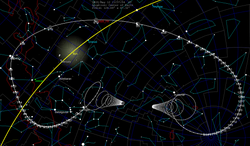C/2020 F8 (SWAN)
C/2020 F8 (SWAN), or Comet SWAN, is an Oort cloud comet that was discovered in images taken by the Solar Wind Anisotropies (SWAN) camera on March 25, 2020, aboard the Solar Heliospheric Observer (SOHO) spacecraft.[2][1] In the glare of twilight, Comet SWAN is difficult to find with 50mm binoculars even though it is still near the theoretical range of naked eye visibility. The comet has dimmed since May 3.[3] As of perihelion, the comet is very diffuse, does not have a visible nucleus and is not a comet that will be noticed by inexperienced observers. It is likely that the comet disintegrated.
_on_1_May_from_Indonesia.jpg) Comet C/2020 F8 (SWAN) on May 1, 2020 from Indonesia | |
| Discovery | |
|---|---|
| Discovered by | Solar and Heliospheric Observatory (SOHO) |
| Discovery date | March 25, 2020[1] |
| Alternative designations | SWAN01 |
| Orbital characteristics A | |
| Epoch | 2020-Apr-25 (JD 2458964.5) |
| Observation arc | 40 days |
| Orbit type | Oort cloud |
| Aphelion | ~1000 AU (outbound) |
| Perihelion | 0.4303 AU (64 million km) |
| Eccentricity | 0.99999 |
| Orbital period | Hyperbolic trajectory (inbound) ~11000 years (outbound) |
| Inclination | 110.8 |
| Earth MOID | 0.1937 AU (29 million km; 75 LD) |
| Last perihelion | May 27, 2020 |
Observing
It is 0.8 AU (120 million km; 310 LD) from Earth in the constellation of Perseus and less than 25 degrees from the Sun. It has an apparent magnitude of 7 and is too diffuse to be visible to the naked eye even from a dark site.[3] The comet is also hidden by the glare of twilight, zodiacal light and atmospheric extinction. It was originally best seen from the Southern Hemisphere. It was expected to possibly reach 3rd magnitude in May, but is now expected to hover closer to magnitude 6.[4] Either way it will be near the glare of twilight.[4] It passed through the celestial equator on 7 May, then it headed northward and it was near the 2nd magnitude star Algol on 20 May.[1] In the Northern Hemisphere it might be best seen at the end of May when it is near the star Capella.

- Sky trajectory with 7 week markers
Orbit

The Minor Planet Center initially listed the orbit as bound with .[2] With a short 18-day observation arc JPL listed the comet as hyperbolic with an eccentricity of 1.0009±0.001, but a longer observation arc was needed to refine the uncertainties and either confirm its hyperbolic trajectory, or determine its orbital period of thousands or millions of years.[5] With a 40-day observation arc it is now known that it came from the Oort cloud on a Hyperbolic trajectory and that the outbound orbit will be ~11,000 years.
On May 12, 2020, the comet passed about 0.56 AU (84 million km; 220 LD) from Earth. On May 27, 2020 the comet came to perihelion 0.43 AU (64 million km) from the Sun.[2]
Gallery
 Photo taken on May 2, 2020[6]
Photo taken on May 2, 2020[6]
References
- "Comet Y4 ATLAS Breaks Up...Enter Comet F8 SWAN". Universe Today. April 15, 2020. Retrieved April 16, 2020.
- "MPEC 2020-G94 : COMET C/2020 F8 (SWAN)". minorplanetcenter.net. Retrieved April 16, 2020.
- Ghosh, Trinankur. "Comet Observation database (COBS)". Retrieved April 28, 2020. "C/2020 F8 (SWAN) plot"
- Seiichi Yoshida (April 13, 2020). "C/2020 F8 ( SWAN )". Retrieved April 16, 2020.
- "JPL Small-Body Database Browser: C/2020 F8 (SWAN)". Jet Propulsion Laboratory. Retrieved April 30, 2020. (JPL solution #1)
- Diego Toscan. "Comet C/2020 F8 SWAN 2 May 2020". Retrieved May 4, 2020.
External links
- C/2020 F8 (SWAN) – Seiichi Yoshida
- C/2020 F8 (SWAN) – JPL
- C/2020 F8 Swan on June 1 (without a defined nucleus) – Michael Jäger
- C/2020 F8 (SWAN) – AiM-Project



